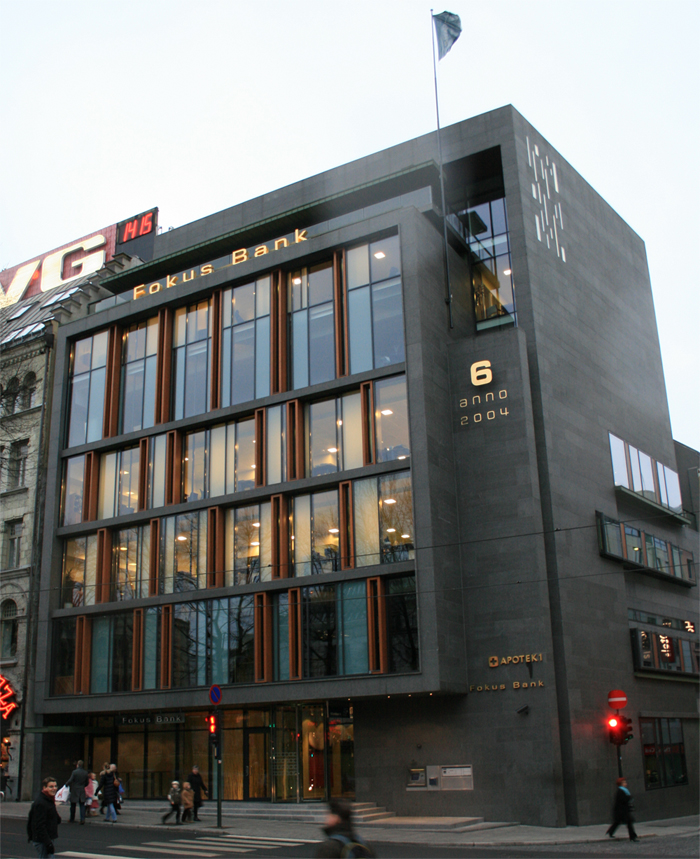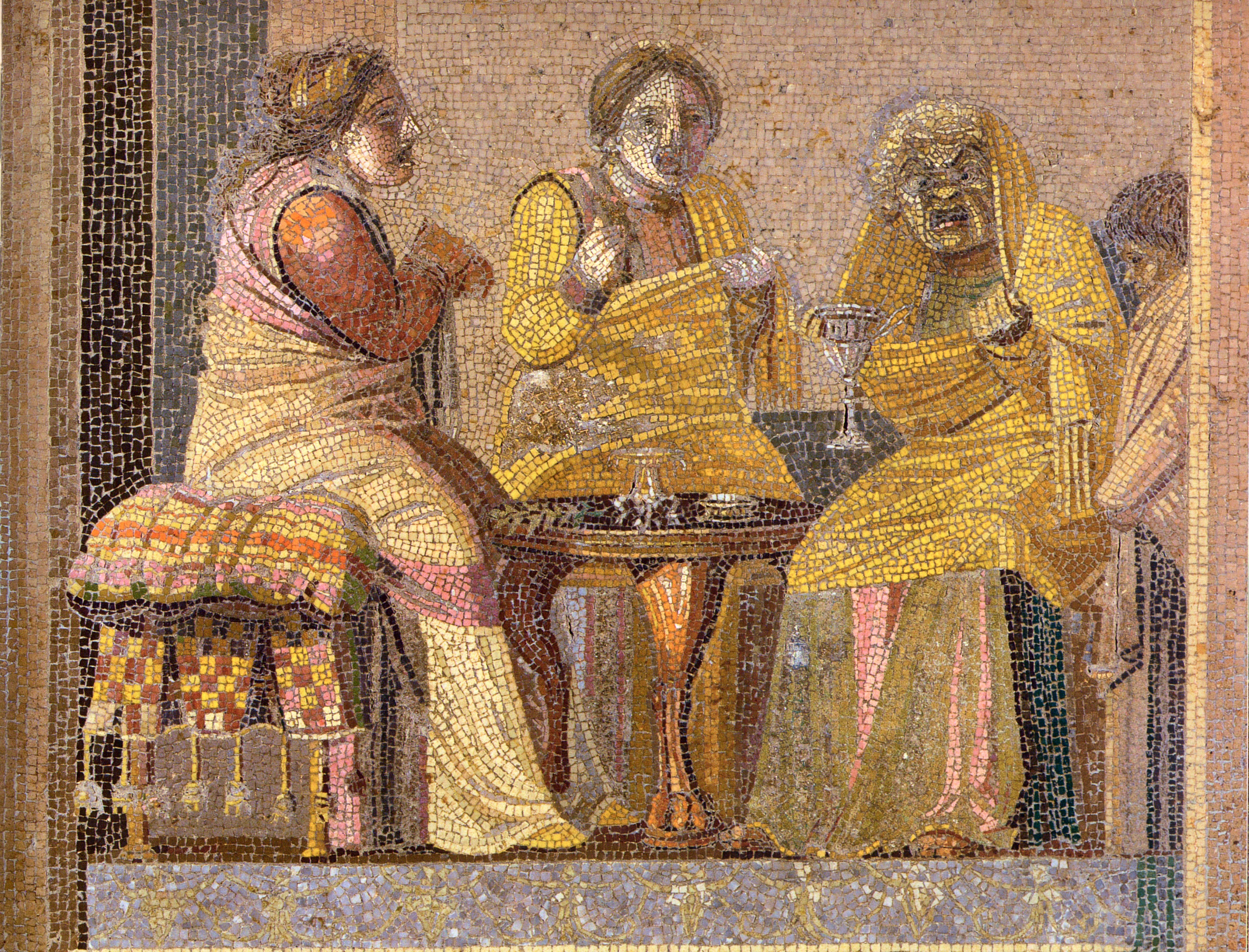|
Oslo Nye Teater
Oslo Nye Teater is a theater located in Oslo, Norway. The theater has its main stage in its own theater house at Rosenkrantz' gate 10. It is one of Norway's most visited theatres. Oslo Nye Teater AS is wholly owned by Oslo Municipality. History The theater opened as Det Nye Teater on February 26, 1929. Architects Gudolf Blakstad (1893–1985) and Jens Dunker (1898–1984) were engaged to design the building resulting in a concrete building in a simplified neoclassical style. In 1994–1995, a thorough upgrade of the audience area in the theater building was carried out under the direction of the architects Kristin Jarmund and Ola Helle. In September 1959, Oslo Nye Teater resulted from a merge between Folketeatret Folketeateret is a theatre in Oslo, Norway. The building has been used as a movie theatre and as an opera house. The theatre has 1,400 seats. History The theatre itself operated from 1952 to 1959, but the institution has a much longer history. ... and De ... [...More Info...] [...Related Items...] OR: [Wikipedia] [Google] [Baidu] |
Oslo New Theater Mainstage Mainentrance
Oslo ( , , or ; sma, Oslove) is the capital and most populous city of Norway. It constitutes both a county and a municipality. The municipality of Oslo had a population of in 2022, while the city's greater urban area had a population of in 2019, and the metropolitan area had an estimated population of in 2021. During the Viking Age the area was part of Viken. Oslo was founded as a city at the end of the Viking Age in 1040 under the name Ánslo, and established as a ''kaupstad'' or trading place in 1048 by Harald Hardrada. The city was elevated to a bishopric in 1070 and a capital under Haakon V of Norway around 1300. Personal unions with Denmark from 1397 to 1523 and again from 1536 to 1814 reduced its influence. After being destroyed by a fire in 1624, during the reign of King Christian IV, a new city was built closer to Akershus Fortress and named Christiania in honour of the king. It became a municipality (''formannskapsdistrikt'') on 1 January 1838. The city functi ... [...More Info...] [...Related Items...] OR: [Wikipedia] [Google] [Baidu] |
Oslo
Oslo ( , , or ; sma, Oslove) is the capital and most populous city of Norway. It constitutes both a county and a municipality. The municipality of Oslo had a population of in 2022, while the city's greater urban area had a population of in 2019, and the metropolitan area had an estimated population of in 2021. During the Viking Age the area was part of Viken. Oslo was founded as a city at the end of the Viking Age in 1040 under the name Ánslo, and established as a ''kaupstad'' or trading place in 1048 by Harald Hardrada. The city was elevated to a bishopric in 1070 and a capital under Haakon V of Norway around 1300. Personal unions with Denmark from 1397 to 1523 and again from 1536 to 1814 reduced its influence. After being destroyed by a fire in 1624, during the reign of King Christian IV, a new city was built closer to Akershus Fortress and named Christiania in honour of the king. It became a municipality ('' formannskapsdistrikt'') on 1 January 1838. The ... [...More Info...] [...Related Items...] OR: [Wikipedia] [Google] [Baidu] |
Norway
Norway, officially the Kingdom of Norway, is a Nordic country in Northern Europe, the mainland territory of which comprises the western and northernmost portion of the Scandinavian Peninsula. The remote Arctic island of Jan Mayen and the archipelago of Svalbard also form part of Norway. Bouvet Island, located in the Subantarctic, is a dependency of Norway; it also lays claims to the Antarctic territories of Peter I Island and Queen Maud Land. The capital and largest city in Norway is Oslo. Norway has a total area of and had a population of 5,425,270 in January 2022. The country shares a long eastern border with Sweden at a length of . It is bordered by Finland and Russia to the northeast and the Skagerrak strait to the south, on the other side of which are Denmark and the United Kingdom. Norway has an extensive coastline, facing the North Atlantic Ocean and the Barents Sea. The maritime influence dominates Norway's climate, with mild lowland temperatures on the sea co ... [...More Info...] [...Related Items...] OR: [Wikipedia] [Google] [Baidu] |
Theatre
Theatre or theater is a collaborative form of performing art that uses live performers, usually actors or actresses, to present the experience of a real or imagined event before a live audience in a specific place, often a stage. The performers may communicate this experience to the audience through combinations of gesture, speech, song, music, and dance. Elements of art, such as painted scenery and stagecraft such as lighting are used to enhance the physicality, presence and immediacy of the experience. The specific place of the performance is also named by the word "theatre" as derived from the Ancient Greek θέατρον (théatron, "a place for viewing"), itself from θεάομαι (theáomai, "to see", "to watch", "to observe"). Modern Western theatre comes, in large measure, from the theatre of ancient Greece, from which it borrows technical terminology, classification into genres, and many of its themes, stock characters, and plot elements. Theatre artist Patr ... [...More Info...] [...Related Items...] OR: [Wikipedia] [Google] [Baidu] |
Gudolf Blakstad
Gudolf Blakstad (19 May 1893 – 22 November 1985) was a Norwegian architect. He was noted for his work in the transition between neo-classicism and functionalism in Norwegian architecture. Biography Blakstad was born in Gjerpen, Norway. He was the son of Wilhelm Eriksen Blakstad (1863-1963) and Gunvor Kjos (1855-1932). Blakstad was educated at the Norwegian Institute of Technology where he graduated in 1916. In 1921 he married Ragnfrid Matheson Brun, in Kristiana, Norway. From 1922 he started his own practice in Oslo together with Arnstein Arneberg and Herman Munthe-Kaas. He would maintain a partnership with Herman Munthe-Kaas in the architectural firm Blakstad og Munthe-Kaas Arkitekter for more than 50 years. During the period 1922–1960, they participated in 66 contests, won prizes in 33 of them, of which all 22 were first prizes. The firm ceased in 1989. The firm collaborated on several significant assignments in Norway including Kunstnernes Hus for which they wer ... [...More Info...] [...Related Items...] OR: [Wikipedia] [Google] [Baidu] |
Kristin Jarmund
. Kristin Jarmund (born 26 September 1954) is a Norwegian architect. Education, carieer and awards Jarmund is a graduate of the Norwegian Technical University in Trondheim (Norwegian Institute of Technology) and the Architectural Association School of Architecture. From 1978 to 1983 she was employed at Telje-Torp-Aasen Arkitektkontor. In 1985 she started her own practice through Kristin Jarmund Arkitekter. The office was among Norway's leading offices and has won or been placed highly in several competitions. For Justervesenet's (Norwegian Metrology Service) new building at Kjeller, the office was awarded the Houens Foundation Award (Houens fonds diplom). Jarmund's work is characterized by clear and simple form, often described as “new-functionalism”. Her design language of remarkable clarity is evident in both color and in the attention to detail. A distinct quality in Jarmund’s work is the importance given to the interior spaces. Jarmund has used the expression “the ... [...More Info...] [...Related Items...] OR: [Wikipedia] [Google] [Baidu] |
Folketeatret
Folketeateret is a theatre in Oslo, Norway. The building has been used as a movie theatre and as an opera house. The theatre has 1,400 seats. History The theatre itself operated from 1952 to 1959, but the institution has a much longer history. Inspired by the Freie Deutsche Volksbühne in Berlin led to forming of interest organizations in Bergen and Oslo in 1928 and 1929. The idea to establish a good theater for the working class. The ''Folketeatret'' building in Oslo was commissioned in 1929, and the architects Christian Morgenstierne (1880–1967) and Arne Eide (1881–1957) worked on it until it opened in 1935. For financial reasons, a theatre did not open immediately, but a movie theatre was operated. The first theatre performance happened in 1952. Hans Jacob Nilsen (1897–1957) was the theatre director from 1952 to 1955, then Jens Gunderssen (1912–1969) from 1955 to 1959. In 1959 the finances were too poor to continue as an independent theatre. ''Folketeatret'' w ... [...More Info...] [...Related Items...] OR: [Wikipedia] [Google] [Baidu] |
Det Nye Teater
Det Nye Teater was a theatre that opened in Oslo in 1929, and ended as an independent theatre in 1959, when it merged with Folketeatret to form Oslo Nye Teater. The theatre's original purpose was to support contemporary Norwegian drama. History The company A/S Det Nye Teater was founded in 1918, by Johan Bojer and Peter Egge. Among the largest financial supporters were ship owner Ivar An Christensen, and also the Norwegian State bought a significant number of shares. The theatre building was designed by the architects Blakstad and Dunker. The theatre's first artistic director was Ingolf Schanche, from 1928 to 1931. The theatre opened on 26 to 28 February 1929, with Knut Hamsun's trilogy, ''Ved rigets port'', ''Livets spil'' and ''Aftenrøde'', followed by Peter Egge's play ''Kjærlighet og venskap''. From 1931 to 1932 Thomas Thomassen managed the theatre, and from 1932 to 1933 Gyda Christensen. Einar Sissener was theatre director from 1933 to 1934, and Hjalmar Friis and Gyda C ... [...More Info...] [...Related Items...] OR: [Wikipedia] [Google] [Baidu] |
Theatres In Oslo
Theatre or theater is a collaborative form of performing art that uses live performers, usually actors or actresses, to present the experience of a real or imagined event before a live audience in a specific place, often a stage. The performers may communicate this experience to the audience through combinations of gesture, speech, song, music, and dance. Elements of art, such as painted scenery and stagecraft such as lighting are used to enhance the physicality, presence and immediacy of the experience. The specific place of the performance is also named by the word "theatre" as derived from the Ancient Greek θέατρον (théatron, "a place for viewing"), itself from θεάομαι (theáomai, "to see", "to watch", "to observe"). Modern Western theatre comes, in large measure, from the theatre of ancient Greece, from which it borrows technical terminology, classification into genres, and many of its themes, stock characters, and plot elements. Theatre artist Patrice ... [...More Info...] [...Related Items...] OR: [Wikipedia] [Google] [Baidu] |
Theatres Completed In 1959
Theatre or theater is a collaborative form of performing art that uses live performers, usually actors or actresses, to present the experience of a real or imagined event before a live audience in a specific place, often a stage. The performers may communicate this experience to the audience through combinations of gesture, speech, song, music, and dance. Elements of art, such as painted scenery and stagecraft such as lighting are used to enhance the physicality, presence and immediacy of the experience. The specific place of the performance is also named by the word "theatre" as derived from the Ancient Greek θέατρον (théatron, "a place for viewing"), itself from θεάομαι (theáomai, "to see", "to watch", "to observe"). Modern Western theatre comes, in large measure, from the theatre of ancient Greece, from which it borrows technical terminology, classification into genres, and many of its themes, stock characters, and plot elements. Theatre artist Patrice ... [...More Info...] [...Related Items...] OR: [Wikipedia] [Google] [Baidu] |







